Ready to ditch the traditional landline but overwhelmed by the options? You're not alone. The shift to Voice over Internet Protocol (VoIP) offers incredible flexibility, advanced features, and significant cost savings, but choosing the best internet telephone service is crucial for ensuring clarity and reliability. A slow or unstable connection can turn crystal-clear calls into a garbled mess, while the wrong feature set can hinder productivity for home offices and businesses alike.
The quality of your internet telephone service is directly tied to the quality of your underlying internet connection. Critical factors like low latency and, most importantly, strong upload speed are non-negotiable for transmitting clear, uninterrupted voice data. This is why a robust internet foundation is the first step toward a great VoIP experience.
This guide cuts through the noise. We will break down the top internet telephone service providers, detailing their unique strengths for different needs, from cost-conscious households using services like magicJack to growing businesses that require a full suite of unified communications tools from providers like RingCentral or 8×8. We'll evaluate each option on call quality, essential features, customer support, and overall value. For those focusing specifically on business solutions, a comprehensive guide on the best VoIP phone systems for small business can provide even more tailored comparisons.
Our goal is to help you find the perfect match for your communication needs, whether you're a remote worker needing flawless video calls or a small business looking to modernize its phone system. Let's dive into the providers that deliver consistent performance and powerful features.
1. Premier Broadband
Premier Broadband establishes itself as a powerful, integrated solution for users who demand more than just a dial tone. It's a top-tier choice for the best internet telephone service because its VoIP offering is built upon a foundation of 100% fiber-optic internet. This unique, unified approach addresses the core requirement for exceptional VoIP performance: a pristine, low-latency, and high-bandwidth connection, making it an ideal platform for both demanding households and sophisticated small businesses.
The service's architecture is its primary differentiator. Unlike VoIP providers that operate over third-party internet connections of varying quality, Premier Broadband controls the entire pipeline. Its symmetrical fiber network delivers identical upload and download speeds, a critical advantage for flawless, high-definition video conferencing, seamless cloud data access during calls, and lag-free communications essential for remote work and competitive gaming.
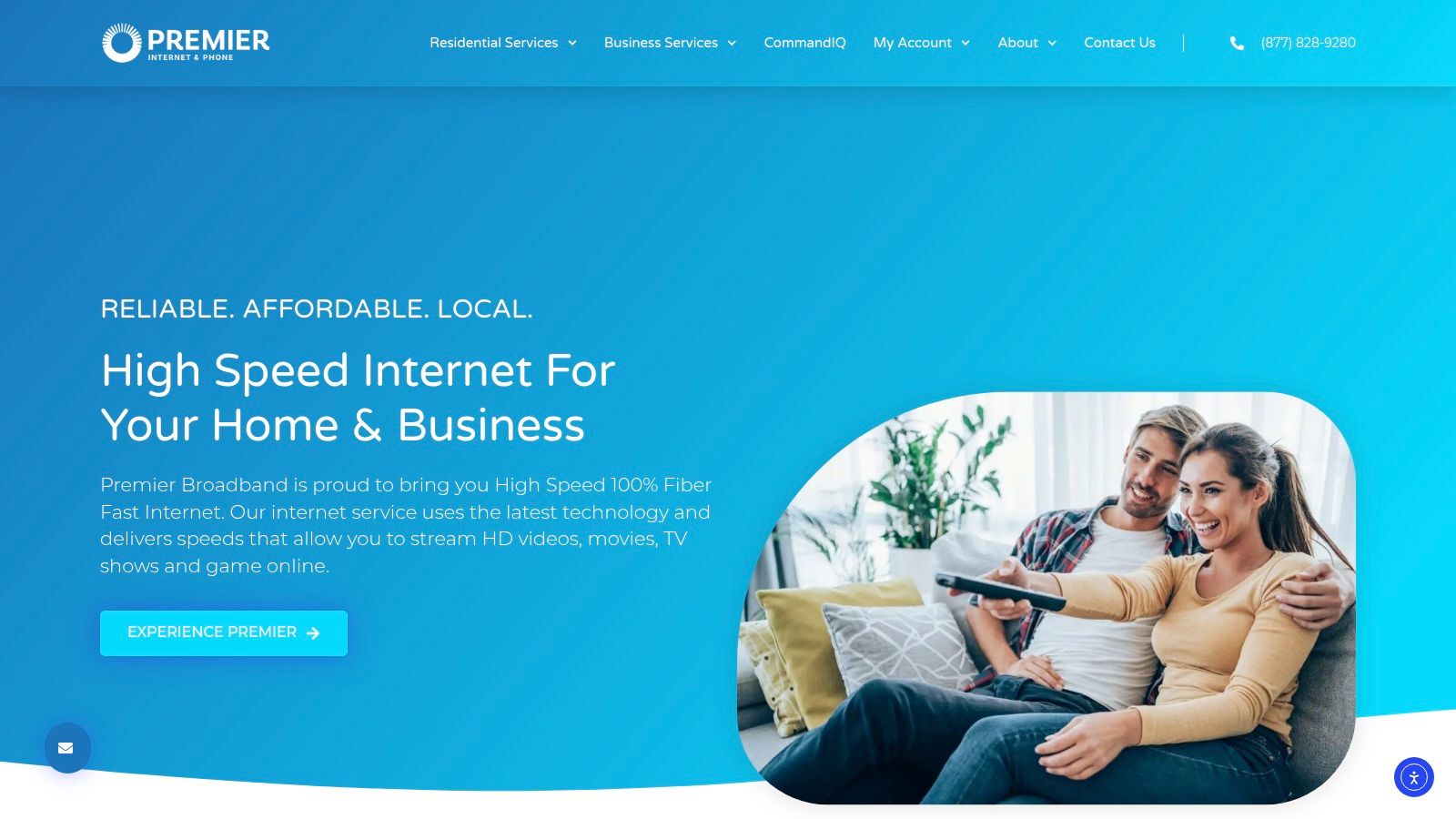
Core Features and Real-World Applications
Premier Broadband’s strength lies in its thoughtfully packaged features that solve common connectivity and communication challenges.
- Integrated VoIP and Data: The platform consolidates internet and voice services under a single, accountable provider. For a small business, this simplifies billing, support, and network management. For a remote worker, it means their critical communication line is backed by the same high-performance fiber ensuring their video calls are crystal clear.
- Business-Grade Voice Features: The VoIP service isn't an afterthought. It includes essential business tools like voicemail-to-email transcription, mobile app integration for on-the-go call management, and custom caller ID. This allows a home-based business to project a professional image without investing in complex, standalone phone systems.
- Residential Plans for Specific Needs: Premier tailors its offerings to distinct user profiles. The "Home Office Hero" plan is a perfect example, guaranteeing the symmetrical speeds necessary for a remote professional juggling video meetings, large file transfers, and cloud application access simultaneously.
- Comprehensive Protection Plans: The Premier Protection Plan adds a layer of practical value by covering equipment repairs and even relocation costs due to unforeseen events like storms or moving. This forward-thinking service reduces the potential for unexpected expenses and downtime.
Why It Stands Out: Beyond the Connection
Premier Broadband’s commitment extends past raw speed. Its partnership with MyBundle.TV provides tangible cost-saving guidance, helping customers navigate the complex streaming landscape and potentially reduce their entertainment expenses significantly compared to traditional cable bundles.
For business clients, the offerings become even more robust. The modular Managed Network Edge service, enterprise-grade hosted VoIP, and AI-powered camera systems create a secure, scalable, and fully managed operational ecosystem. This allows a growing business to deploy sophisticated technology without needing a dedicated in-house IT team, simplifying operations and ensuring security under a single, reliable vendor.
Availability and Pricing
Premier Broadband operates with a local-first, community-focused infrastructure model. This means its state-of-the-art fiber service is not yet available nationwide. Availability is contingent on their regional network buildouts.
The company does not list specific plan pricing on its website, opting for a personalized consultation approach. Prospective customers need to contact Premier directly to confirm service availability in their area and receive a quote tailored to their specific needs.
Pros:
- True 100% fiber network with symmetrical speeds for superior call quality.
- Unified voice and data simplifies billing and technical support.
- Comprehensive protection plans cover equipment and relocation.
- Advanced business solutions like Managed Network Edge and AI cameras.
- Streaming savings guidance through a MyBundle.TV partnership.
Cons:
- Service availability is limited to its specific fiber network regions.
- Pricing is not transparent on the website and requires a direct inquiry.
For users within its service area, Premier Broadband offers one of the most robust and reliable platforms for integrated internet and voice, making it a definitive contender for the best internet telephone service.
Website: https://premierbroadband.com
2. RingCentral (RingEX)
RingCentral, now branded as RingEX, represents a significant step up into the world of Unified Communications as a Service (UCaaS). It’s more than just an internet telephone service; it's a comprehensive communications hub designed to scale from a small, ambitious team to a large, distributed enterprise. This platform consolidates voice, video, team messaging, and SMS into a single, cohesive application, making it a powerful choice for businesses that need an all-in-one solution.
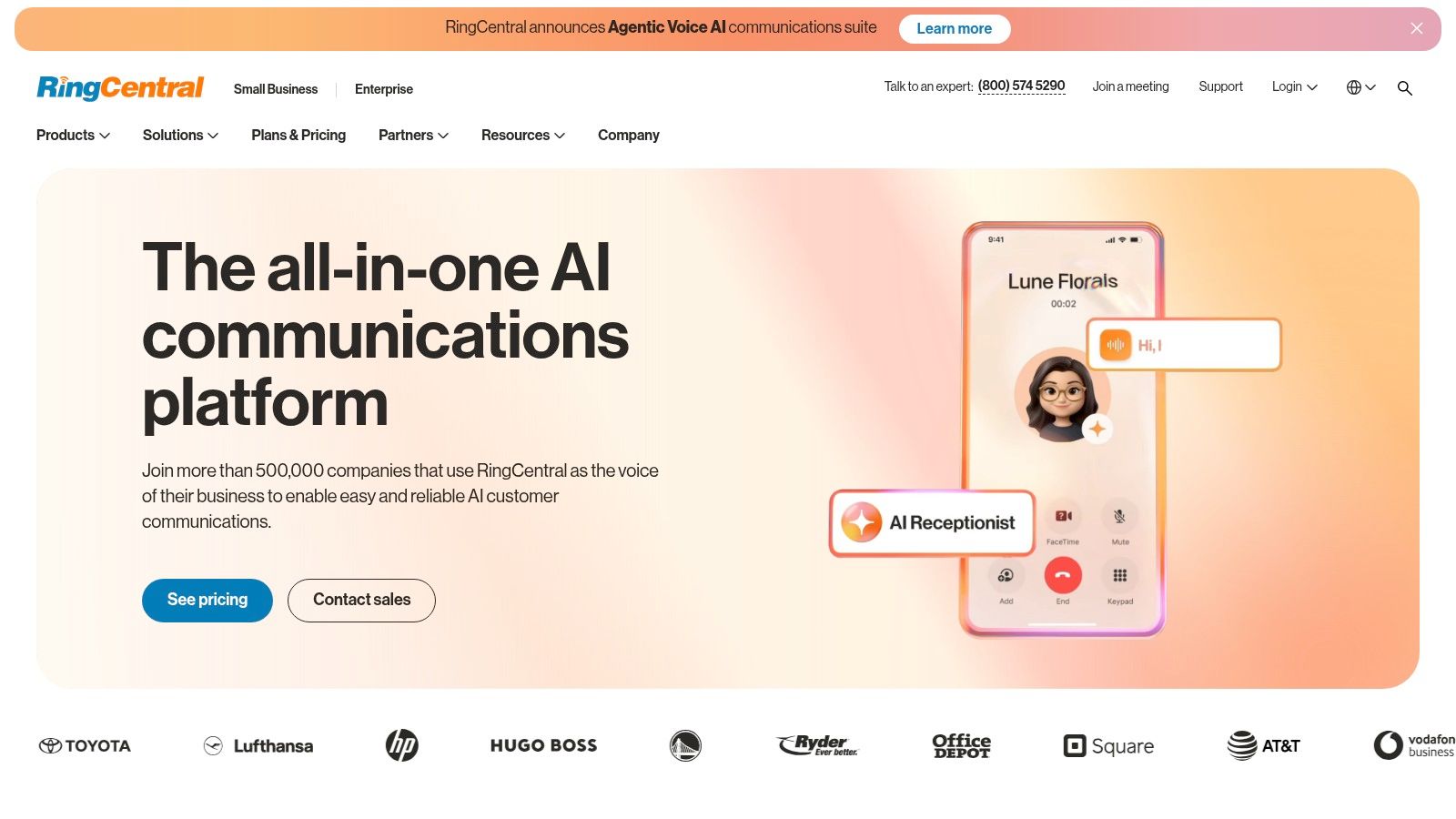
What truly sets RingCentral apart is its enterprise-grade feature depth and immense integration capabilities. It’s built for businesses that want their phone system to be the central nervous system of their operations, connecting seamlessly with other critical software. This makes it one of the best internet telephone service options for companies aiming for high growth and operational efficiency.
Key Features and User Experience
RingCentral’s platform is packed with sophisticated tools that go beyond basic calling. Users get access to a powerful suite of features designed to enhance productivity and professional communication.
- Unified Communications: The desktop and mobile apps provide a single interface for HD voice and video calls, team chat, file sharing, and task management. This consolidation reduces the need to switch between different applications.
- Advanced Call Management: Features like multi-level auto-attendant, call recording, hot-desking, and advanced call monitoring tools (barge, whisper, takeover) give administrators granular control over call flows and quality assurance.
- Extensive Integrations: With over 300 pre-built integrations, RingCentral connects directly with essential business tools like Salesforce, Microsoft 365, and Google Workspace, embedding communication functions directly into your existing workflows.
- AI-Powered Insights: RingSense AI offers real-time call transcription, closed captions, and automated meeting summaries. This technology helps capture key action items and insights without manual note-taking.
Pricing and Ideal Use Case
RingCentral’s pricing reflects its robust feature set, starting around $20 per user per month for its Core plan and scaling up for Advanced and Ultra tiers. While its list price can be higher than some simpler VoIP providers, the value is in its comprehensive, all-in-one platform.
This service is ideal for: Growth-focused small businesses and mid-to-large enterprises that need a scalable, feature-rich phone system with deep integration capabilities. If your business relies on CRM, productivity suites, and data-driven insights, RingCentral provides the connective tissue to unify them. The powerful SMS and MMS features are also a major draw, and you can learn more about how VoIP enhances text messaging for business.
Pros:
- Broad, enterprise-grade feature set that scales with your business
- Vast integration ecosystem and open APIs for custom solutions
- Consistently recognized as an industry leader for innovation
Cons:
- Higher list pricing compared to some SMB-focused competitors
- The extensive features can present a learning curve for new users
Website: https://www.ringcentral.com
3. Google Voice (for Google Workspace)
For businesses already embedded in the Google ecosystem, Google Voice for Google Workspace offers a seamless and intuitive internet telephone service. It extends the familiar Google user experience to your business phone system, integrating directly with tools like Gmail, Calendar, and Meet. Rather than being a standalone, complex communications suite, Google Voice acts as a natural extension of the productivity tools your team already uses daily, making it a powerful and straightforward choice.

What sets Google Voice apart is its simplicity and deep integration within its native environment. It’s designed for organizations that want a reliable, no-fuss cloud phone system without the steep learning curve of more feature-heavy UCaaS platforms. This focus on ease of use and native functionality makes it one of the best internet telephone service options for companies that prioritize efficiency and a unified Google-centric workflow.
Key Features and User Experience
Google Voice delivers a clean, focused feature set that covers the essential needs of most small to medium-sized businesses, all managed from the familiar Google Admin console.
- Native Google Integration: Make and receive calls directly from Gmail or the dedicated Voice mobile app. Schedule meetings in Calendar that automatically include call-in numbers, creating a fluid communication experience.
- Simple Call Management: The Standard and Premier plans include core business features like multi-level auto-attendants to direct callers and ring groups to distribute calls across teams or departments.
- Cross-Platform Accessibility: Users can manage their business line from a web browser, a dedicated mobile app for iOS and Android, or through compatible desk phones and analog telephone adapters (ATAs).
- Advanced Administration and Reporting: Higher-tier plans unlock powerful tools for administrators, including eDiscovery for data retention, detailed reporting via BigQuery, and automatic call recording for compliance and training.
Pricing and Ideal Use Case
Google Voice’s pricing is highly competitive, starting around $10 per user per month for the Starter plan. A key requirement is that all users must also have an active Google Workspace subscription, which is an additional cost. The service scales up with Standard and Premier tiers that add more advanced features like ring groups and international calling locations.
This service is ideal for: Small to medium-sized businesses and startups that are heavily invested in the Google Workspace ecosystem. If your team lives in Gmail, Calendar, and Drive, Google Voice provides a cost-effective and perfectly integrated phone system that feels like a natural part of your existing tools, eliminating the need to onboard a separate platform.
Pros:
- Very competitive entry-level pricing for small teams
- Seamless integration and familiar experience within Google Workspace
- Simple to deploy and manage via the Google Admin console
Cons:
- Requires a paid Google Workspace subscription for each user
- Limited third-party integrations compared to broader UCaaS suites
- The Starter plan is capped at 10 users and domestic locations
Website: https://workspace.google.com/products/voice/
4. Ooma (Home and Ooma Office)
Ooma carves out a unique space in the VoIP market by excelling at both residential and small business solutions with a strong emphasis on simplicity and affordability. It bridges the gap between basic home phone replacement and a full-featured office system, making it an incredibly versatile internet telephone service. The platform is known for its straightforward setup, often involving proprietary hardware like the Ooma Telo for homes or various IP phones for businesses.
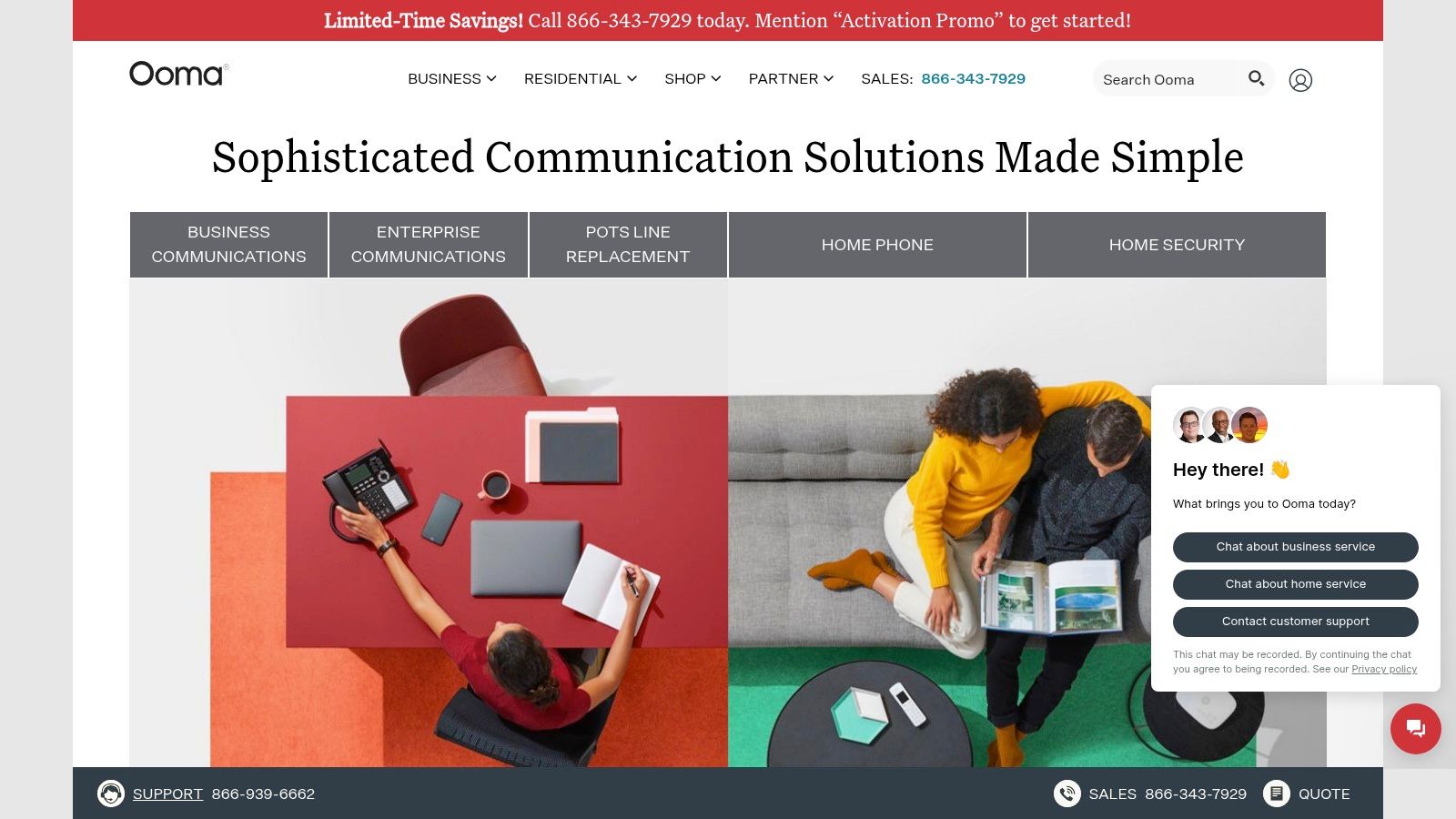
What makes Ooma stand out is its hardware-centric approach combined with clear, predictable pricing. For homeowners, it’s a cost-effective way to keep a landline-style phone number over the internet. For small businesses, Ooma Office provides essential communication tools without the complexity or cost of enterprise-level systems. This focus on ease of use and value makes it a top contender for users who need reliability without an overwhelming number of features.
Key Features and User Experience
Ooma's platform is designed for accessibility, ensuring users can get up and running quickly. Both its residential and business offerings provide a solid foundation of calling features that cater to their respective audiences.
- Generous Calling Plans: Ooma Office plans include unlimited calling to the U.S., Canada, Mexico, and Puerto Rico, providing predictable monthly costs for businesses that communicate frequently across North America.
- Essential Business Tools: Features like a virtual receptionist, call recording, and voicemail transcription are included in business plans. Higher tiers add powerful tools like call queues and hot-desking for more dynamic office environments.
- Hardware Flexibility: Ooma offers a mix-and-match approach to hardware. Businesses can purchase Ooma-branded IP phones or use analog telephone adapters (ATAs) to connect existing traditional phones to the VoIP network.
- Simple Setup: The plug-and-play nature of Ooma's hardware is a major selling point. However, it's worth noting that some home network configurations might interfere with VoIP traffic; understanding what SIP ALG is and how it affects calls can help troubleshoot potential issues.
Pricing and Ideal Use Case
Ooma’s pricing is one of its most attractive aspects. The residential service involves a one-time hardware purchase followed by minimal monthly taxes and fees. Ooma Office starts at a very competitive price point of around $19.95 per user per month, with higher tiers unlocking more advanced features like video conferencing and CRM integrations.
This service is ideal for: Homeowners looking for a cheap and reliable landline alternative and for small businesses that need a professional, no-frills phone system. Its simplicity and cost-effectiveness are perfect for startups, retail shops, and professional services that require dependable communication tools without a steep learning curve or high overhead.
Pros:
- Clear, predictable, and SMB-friendly pricing structure
- Excellent option for residential users wanting to replace a traditional landline
- Easy-to-install hardware available directly from Ooma
Cons:
- Advanced features like CRM integrations and analytics are locked behind higher-priced tiers
- Some users report difficulty downgrading from promotional residential plans
Website: https://www.ooma.com
5. Vonage Business Communications (VBC)
Vonage Business Communications (VBC) is a highly flexible and well-known Unified Communications as a Service (UCaaS) platform tailored for small to mid-market businesses. It provides a reliable, cloud-based phone system that combines voice, messaging, and video into one streamlined solution. Where Vonage carves out its space is in its blend of a comprehensive feature set with competitive, often promotional, pricing, making it an accessible entry point for businesses looking to upgrade from traditional landlines.
What makes Vonage a contender for the best internet telephone service is its focus on delivering core business communication tools effectively and affordably. It’s built for companies that need dependable calling, robust mobile functionality, and the ability to scale without complexity. Its platform is straightforward enough for a small team to manage but powerful enough to support a growing organization's evolving needs, including potential expansion into advanced APIs and contact center solutions.
Key Features and User Experience
Vonage equips businesses with over 50 essential phone features designed to create a professional and efficient communication environment. The user experience is centered around its intuitive desktop and mobile applications, ensuring seamless connectivity in or out of the office.
- Unlimited Calling and Messaging: All VBC plans include unlimited calls and SMS within the U.S., Canada, and Mexico, along with team messaging for internal collaboration. This predictable pricing is ideal for businesses with high call volumes.
- Comprehensive Phone System Features: The platform includes standard but crucial tools like a virtual receptionist (auto-attendant), call forwarding, voicemail-to-email, and call logs. Higher-tier plans add call recording and visual voicemail.
- Mobile and Desktop Integration: The VBC apps for desktop and mobile devices allow employees to make and receive business calls on any device, using their business number. This is essential for supporting remote and hybrid work models.
- Scalability into APIs and Contact Centers: A key differentiator is Vonage’s broader ecosystem. Businesses can start with VBC and later integrate Vonage Communications APIs for custom workflows or upgrade to its full-featured contact center platform as their needs grow.
Pricing and Ideal Use Case
Vonage’s pricing is often its main attraction, with promotional rates for new customers starting around $14.99 per user per month. The best pricing typically requires an annual commitment, and costs increase for its Premium and Advanced tiers, which add features like CRM integrations and desk phone support.
This service is ideal for: Small to medium-sized businesses that need a dependable, full-featured phone system without a steep learning curve or high upfront cost. Companies that value straightforward unlimited calling and SMS, strong mobile app performance, and a clear path to scale will find Vonage to be a strong fit. Pairing it with a reliable fiber connection is key, and you can explore great internet and phone bundles for small business.
Pros:
- Competitive promotional pricing and volume discounts make it budget-friendly
- Solid baseline feature set that covers typical business calling needs effectively
- Strong mobile and desktop applications for a unified experience
Cons:
- Best online prices are generally tied to 12-month commitments with potential early termination fees
- Fewer AI-forward features at base tiers compared to some competitors
Website: https://www.vonage.com
6. 8×8 (X Series)
8×8 offers a powerful and globally-focused platform through its X Series, positioning itself as a leader in integrated Unified Communications (UCaaS) and Contact Center as a Service (CCaaS). It’s designed for businesses with a distributed or international footprint, combining voice, video, chat, and contact center functionalities into a single cloud solution. This comprehensive approach ensures that companies can manage all their communications, from internal collaboration to external customer service, on one cohesive system.

What makes 8×8 a standout contender for the best internet telephone service is its robust international calling capabilities and its deep integration with Microsoft Teams. For organizations that operate across multiple countries or rely heavily on the Teams ecosystem, 8×8 provides a seamless and cost-effective way to unify communications without sacrificing enterprise-grade reliability, all supported by its geo-redundant network backbone.
Key Features and User Experience
8×8’s X Series plans are designed to be flexible, allowing businesses to mix and match licenses to fit the specific needs of different users, from standard office workers to advanced contact center agents.
- Integrated UCaaS and CCaaS: The X Series plans (like X2, X4 for UCaaS and X6-X8 for contact centers) allow a business to operate its phone system and customer service center from the same vendor, ensuring a smooth flow of information and better analytics.
- Extensive International Calling: Higher-tier plans include unlimited voice calling to a large list of countries (up to 48), making it an extremely attractive option for businesses with significant international operations, eliminating unpredictable per-minute charges.
- Deep Microsoft Teams Integration: 8×8 offers multiple ways to integrate with Teams. This includes the 8×8 Voice for Microsoft Teams app, which allows users to make and receive global PSTN calls directly within the Teams interface without needing a separate Teams Phone license from Microsoft.
- High Reliability and Security: The platform is built on a geo-redundant infrastructure, providing strong uptime guarantees. It also maintains compliance with major industry standards like HIPAA and PCI-DSS, making it suitable for sensitive environments.
Pricing and Ideal Use Case
8×8’s pricing for its X Series starts with the X2 plan, which is competitively positioned for small to mid-sized businesses. Higher-tier plans for contact center features or expanded international calling require a custom quote, reflecting their enterprise focus. This tailored approach ensures businesses only pay for the features they need.
This service is ideal for: Multinational corporations and businesses with distributed teams that require extensive, cost-effective international calling. It is also a top choice for organizations heavily invested in the Microsoft Teams ecosystem that want to add robust, global telephony capabilities without the complexity and cost of native Microsoft solutions.
Pros:
- Strong international coverage with unlimited calling to many countries
- Deep and flexible Microsoft Teams integration options
- Combines UCaaS and CCaaS on a single, reliable platform
Cons:
- Pricing for higher-tier plans is often not transparent and requires a direct quote
- Some online user reviews mention a learning curve with the admin portal
Website: https://www.8×8.com
7. magicJack (Home VoIP)
magicJack represents a unique and highly accessible entry point into the world of internet telephone service, primarily targeting the residential market. Instead of a cloud-based software subscription, its core offering is a small physical device that plugs into your computer’s USB port or directly into your router. This simplicity and ultra-low-cost model have made it a popular replacement for traditional landlines for decades, offering basic, reliable calling without the complexity or price tag of business-focused systems.
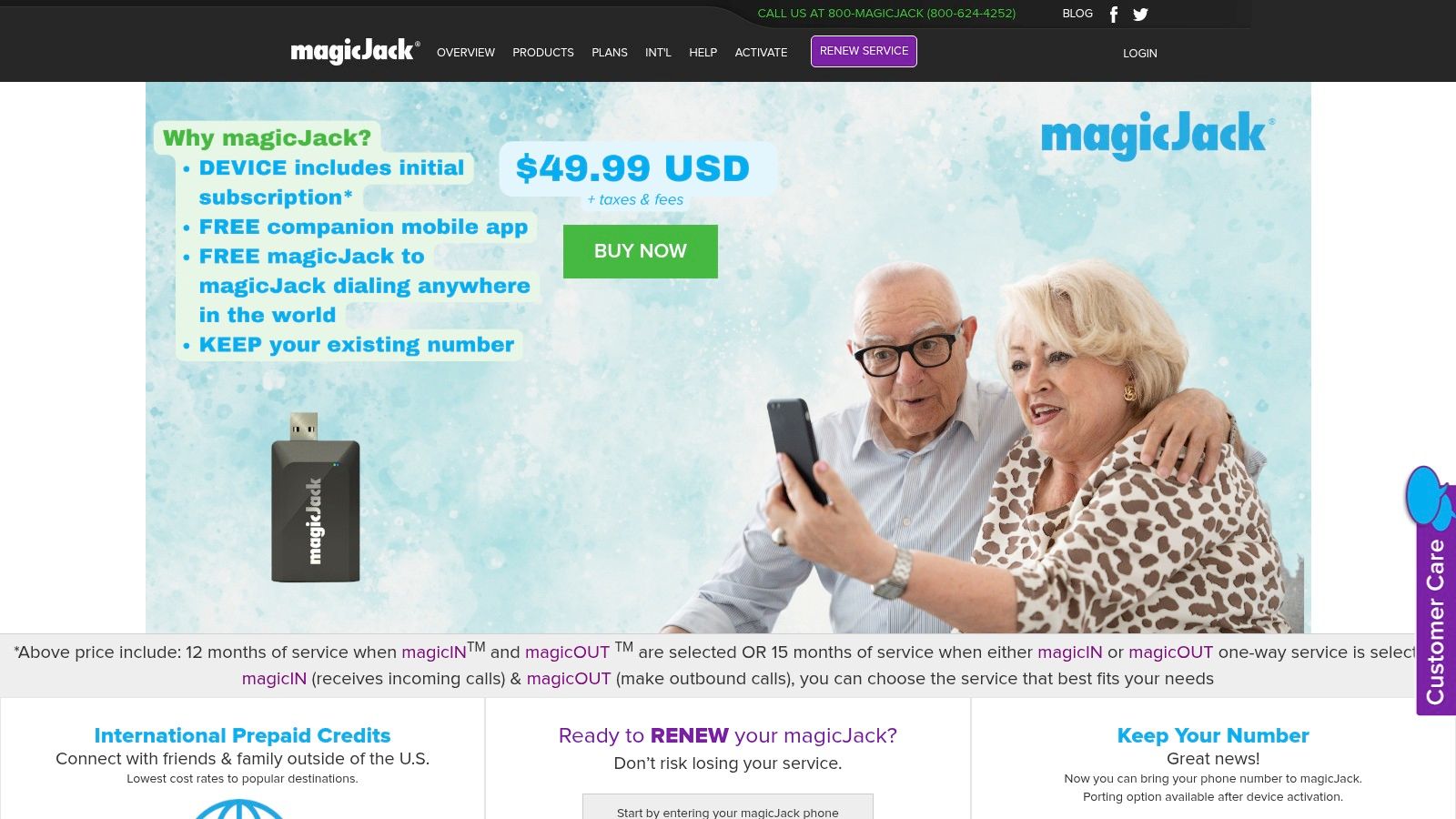
What truly sets magicJack apart is its straightforward value proposition: pay a small one-time fee for the device, which includes a full year of service, and then a low annual fee thereafter. This model demystifies VoIP for the average home user, making it an excellent choice for anyone who just needs a dependable home phone number for unlimited local and long-distance calls across the U.S. and Canada. It strips away the enterprise features to deliver pure, cost-effective communication.
Key Features and User Experience
magicJack’s platform is built around ease of use and affordability, providing essential calling features without overwhelming the user. The experience is designed to be plug-and-play, getting you up and running in minutes.
- Simple Hardware Setup: The core of the service is the magicJack device. You simply connect it to your router and a standard telephone, and your internet phone line is active. No complex configuration is required.
- Companion Mobile App: The service includes a free mobile app for iOS and Android. This allows you to make and receive calls on your smartphone using your magicJack number over Wi-Fi, effectively turning your mobile phone into a second home phone line.
- Essential Calling Features: Despite its simplicity, magicJack includes all the necessary features for a home phone. Users get voicemail, caller ID, call waiting, and call forwarding at no extra cost.
- Number Porting and Selection: You can choose a new phone number or, for a one-time fee, port your existing landline or cell number over to the service to maintain continuity.
Pricing and Ideal Use Case
magicJack’s pricing is its most compelling feature. The initial purchase of a device typically costs around $40-$60, which includes the first 12 months of service. After the first year, renewal plans are exceptionally low, often costing less for an entire year than what many competitors charge for a single month.
This service is ideal for: Cost-conscious households, seniors, and students who want a simple, no-frills replacement for a traditional landline. It’s perfect for anyone who needs a reliable home phone for basic calling needs without being tied to a monthly subscription fee. Its straightforward setup makes it one of the best internet telephone service options for non-technical users.
Pros:
- Extremely low first-year cost and affordable annual renewal rates
- Very simple plug-and-play setup requires minimal technical knowledge
- Companion mobile app adds significant value and flexibility
Cons:
- Primarily designed for residential use with limited business features
- Customer support options are less robust than premium business providers
- Call quality can be more dependent on your home internet stability
Website: https://www.magicjack.com
Top 7 Internet Telephone Services Comparison
| Service | 🔄 Implementation complexity | ⚡ Resource requirements | ⭐ Expected outcomes | 💡 Ideal use cases | 📊 Key advantages |
|---|---|---|---|---|---|
| Premier Broadband | Medium — fiber installation and local provisioning | Fiber connection, managed Wi‑Fi, possible professional install | Very high reliability and low latency (⭐⭐⭐⭐⭐) | Homes & small businesses needing symmetric fiber, gaming, streaming, unified VoIP | 100% symmetric fiber; integrated VoIP; protection plans; modular business services |
| RingCentral (RingEX) | High — enterprise deployment and admin controls | Cloud subscription, IT/admin resources, integrations | High scalability and feature depth (⭐⭐⭐⭐) | Mid-to-large organizations requiring UCaaS, integrations, advanced telephony | Extensive integrations, rich call features, AI meeting tools |
| Google Voice (for Workspace) | Low — simple setup within Google Workspace | Paid Google Workspace subscription; minimal IT overhead | Good for straightforward business calling (⭐⭐⭐) | Teams already on Google Workspace seeking low-cost cloud phone | Seamless Workspace integration; competitive entry pricing |
| Ooma (Home & Office) | Low–Medium — easy residential setup; SMB tier setup | Per-user plans, optional branded hardware or ATAs | Reliable basic calling for home/SMB (⭐⭐⭐) | Small businesses and residential users replacing landlines | Clear SMB pricing, available hardware, predictable plans |
| Vonage Business Communications (VBC) | Medium — standard UCaaS setup, optional expansions | Cloud plans; best rates often with annual commitments | Solid business calling with room to scale (⭐⭐⭐–⭐⭐⭐⭐) | SMBs seeking competitive pricing and optional APIs/contact center | Promotional pricing, broad feature set, API/contact center options |
| 8×8 (X Series) | Medium–High — global & contact-center configuration | Cloud subscription, international PSTN, admin support | Strong international calling and redundancy (⭐⭐⭐⭐) | Distributed/global teams needing wide country coverage and Teams interoperability | Large international calling bundles, Teams integration, geo-redundant backbone |
| magicJack (Home VoIP) | Very Low — plug-and-play device/ATA | Small device + minimal subscription; home internet | Basic, low-cost home calling (⭐⭐) | Cost-conscious home users wanting minimal monthly expense | Ultra-low cost, extremely simple setup |
Making the Right Call for Your Connectivity Needs
Navigating the landscape of modern communication has revealed a fundamental truth: the best internet telephone service is not a one-size-fits-all solution. It's a strategic choice that must align perfectly with your unique operational needs, budget, and technical requirements. Throughout this guide, we've explored a range of powerful VoIP solutions, from enterprise-grade platforms to simple residential adapters, each offering distinct advantages for specific use cases.
The key takeaway is that your decision should be driven by a clear understanding of your primary communication goals. Are you a small business looking for a comprehensive, all-in-one platform with deep CRM integrations and advanced analytics? In that case, a robust service like RingCentral (RingEX) or 8×8 (X Series) provides the scalable, feature-rich environment you need to manage a professional communication stack. Conversely, if your team is deeply embedded in the Google ecosystem, the seamless integration and cost-effectiveness of Google Voice for Google Workspace present a compelling and logical choice.
For home users or micro-businesses seeking simplicity and affordability, providers like Ooma and magicJack deliver reliable, no-frills calling without the complexity or cost of enterprise systems. Their straightforward setup and predictable pricing make them excellent entry points into the world of VoIP.
The Deciding Factor: Your Internet Connection
While features and pricing are critical comparison points, they are secondary to the most important factor influencing your VoIP experience: the quality of your internet connection. A feature-packed cloud phone system is rendered ineffective by a network plagued with high latency, jitter, and insufficient upload bandwidth. Dropped calls, robotic-sounding voices, and frustrating delays are almost always symptoms of a poor connection, not a poor VoIP provider.
This is where the conversation shifts from what service you use to how it's delivered. The underlying infrastructure is the foundation of clear, reliable communication.
Key Insight: The performance of even the most advanced internet telephone service is fundamentally limited by the internet connection it runs on. Prioritizing a high-quality, stable, and symmetrical internet connection is the single most important step you can take to ensure exceptional call quality.
From Good to Great: Matching Your Service to Your Needs
To make your final decision, move beyond a simple feature checklist and consider these practical implementation scenarios:
- For the Remote Worker or Home Office: Your primary need is unwavering reliability for video conferences and voice calls. Your voice needs to be transmitted as clearly as it is received. This makes a symmetrical fiber internet connection non-negotiable. Pairing a service like Vonage or Ooma Office with a powerful network ensures you maintain a professional presence.
- For the Growing Small Business: You need scalability, professional features like an auto-attendant and call routing, and mobile app integration for on-the-go employees. RingCentral or 8×8 are built for this, but their performance depends on a business-grade internet connection that can handle concurrent calls, data backups, and other cloud services without compromise.
- For the Budget-Conscious Household: Your goal is to replace an expensive landline with a simple, cost-effective alternative for domestic and international calling. A plug-and-play device like magicJack, supported by a stable broadband connection, is often the most direct and economical solution.
Ultimately, the path to superior communication begins at the source. Choosing a VoIP provider is only half the equation. The other, more critical half is ensuring the digital highway your voice travels on is clear, fast, and reliable. An integrated solution that pairs a top-tier internet telephone service with a purpose-built fiber network eliminates the guesswork and addresses the root cause of common VoIP frustrations, creating a truly seamless and powerful communication experience from end to end.
Ready to build your communication on a foundation of pure speed and reliability? Explore how Premier Broadband's 100% fiber network and integrated VoIP solutions can deliver the crystal-clear call quality your home or business deserves. Visit Premier Broadband to see how a superior connection transforms your communication experience.

